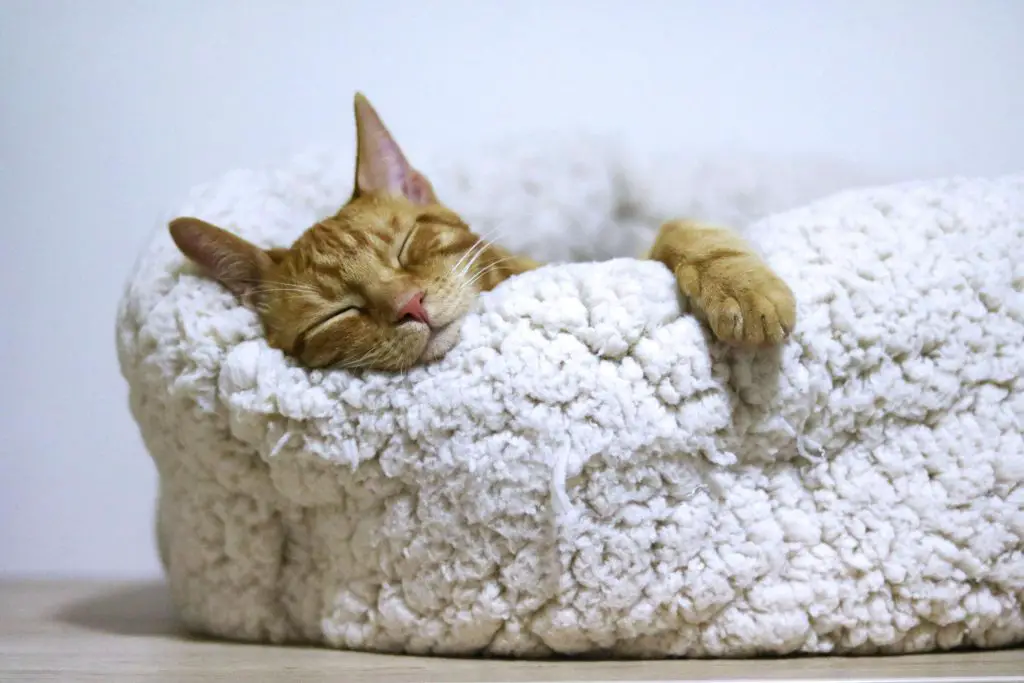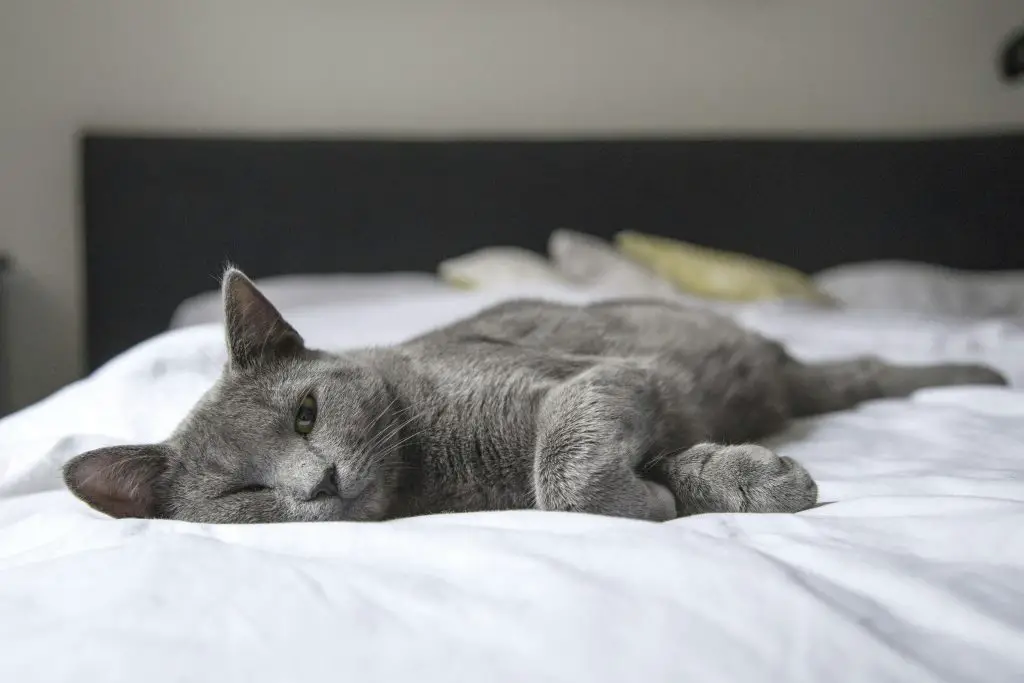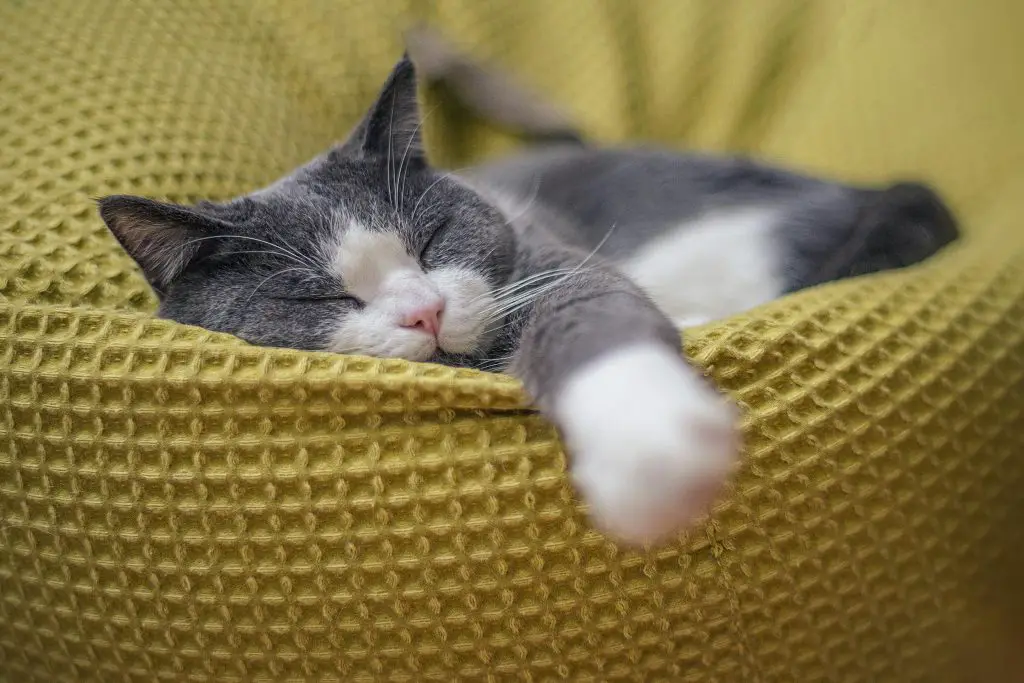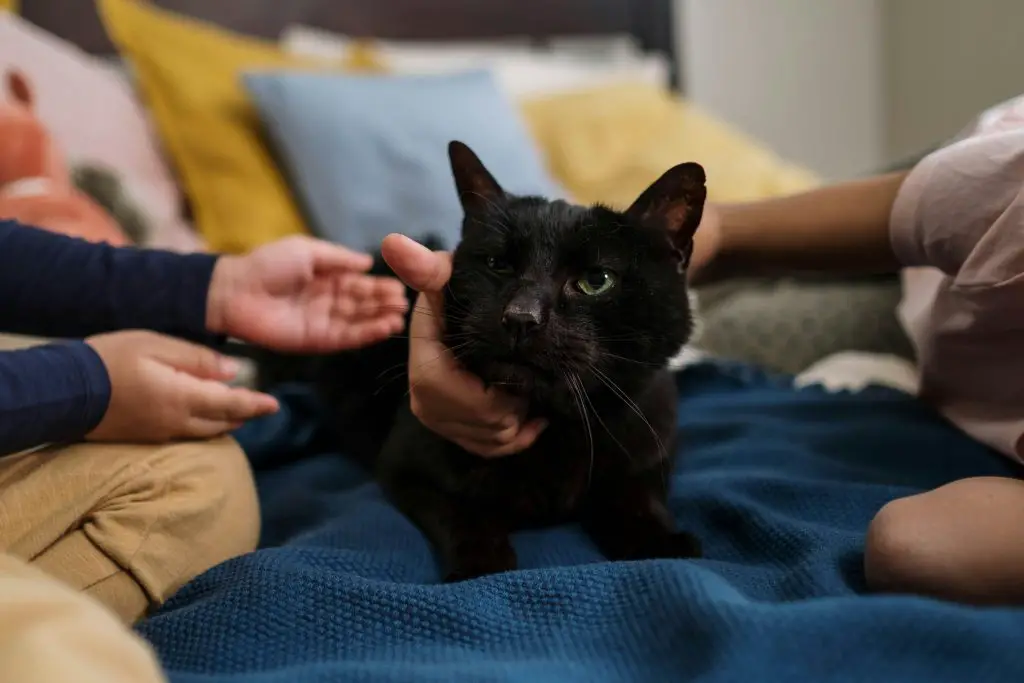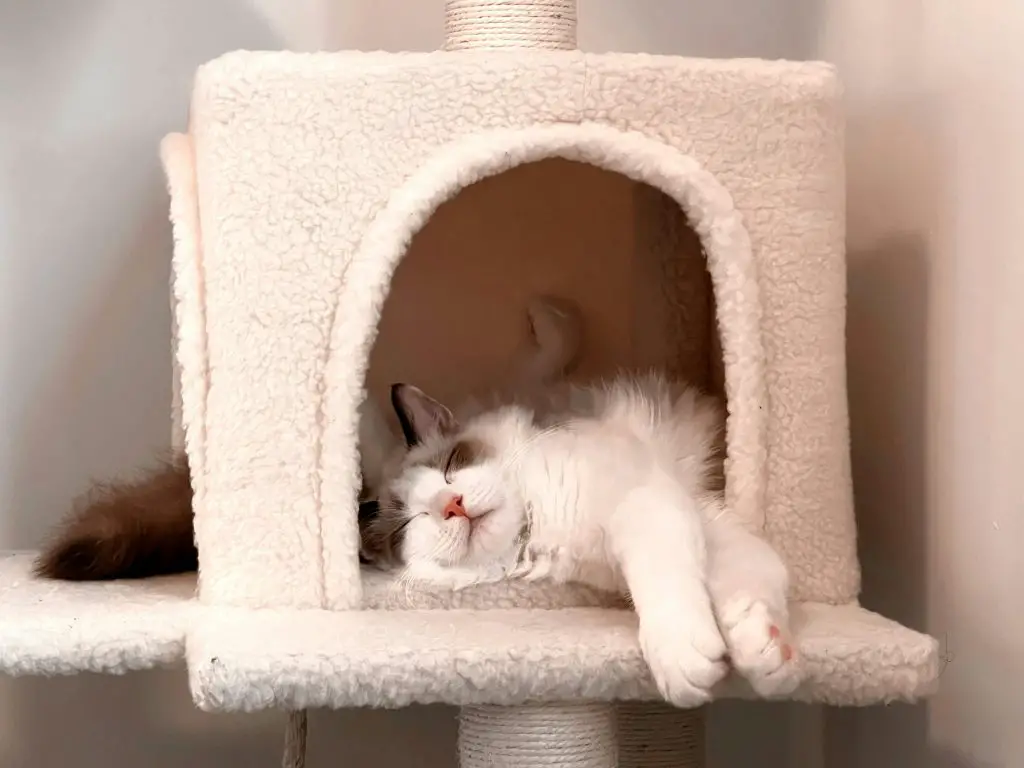To train your cat to sleep at night, understand their crepuscular nature. Structure their daytime with morning play, midday puzzles, and evening play and treat puzzles before bedtime.
Shift feeding times to later in the evening and maintain consistency. Create a cozy, quiet sleeping area, possibly with cat trees or elevated perches.
Employ calming products like feline pheromone diffusers and catnip toys. Establish a bedtime routine with calming activities and limited light exposure.
Be patient and stick to the routine, as cats thrive on consistency. To explore further strategies, there’s rich information available for optimizing your cat’s rest. Also you can learn how to stop your cat from biting and attacking you.
- Engage in vigorous play sessions before bedtime to tire your cat out.
- Gradually shift feeding times to later in the evening to align with your sleep schedule.
- Use calming products like feline pheromone diffusers to create a soothing environment.
- Establish a consistent bedtime routine with calming activities and predictable schedules.
- Create a designated sleeping area in a quiet, dark part of the home for undisturbed rest.
Table of Contents
Understand Your Cat’s Behavior
Understanding your cat’s nocturnal instincts and natural hunting behaviors is crucial for modifying their sleep patterns. Cats are crepuscular by nature, meaning they’re most active during dawn and dusk.
This post contains affiliate links. However all the information provided on this site are my own honest opinions. See more in Disclaimer.
This behavior stems from their wild ancestors, who hunted during these low-light periods to avoid larger predators and catch more prey.
Recognizing this feline instinct is the first step in addressing your cat’s nighttime habits. You’ll notice your cat engaging in bursts of energy at night, often referred to as the ‘zoomies.’ These behaviors are tied to their innate need to hunt and explore.
By understanding this, you can start to adjust their environment and routines to better align with your own sleep patterns. Pay attention to your cat’s sleep patterns throughout the day.
Cats typically sleep 12-16 hours daily, often in short naps rather than one long rest.
This polyphasic sleep cycle means they’re ready to be active when you’re winding down. To modify this, you’ll need to gradually shift their activity to more suitable times. Use this knowledge of cat behavior and feline instincts to help your furry friend adapt.
You’ll make both of your lives more harmonious and restful.
Create a Daytime Activity Schedule
To align your cat’s energy levels with your own schedule, establish a structured daytime activity plan that engages their natural instincts. Cats are crepuscular, meaning they’re naturally active during dawn and dusk, but you can help them adjust.
By providing consistent and stimulating activities, you can reduce their nighttime restlessness. Here’s how to create an effective playtime schedule for prime cat enrichment:
- Morning Play Session: Start the day with a burst of energy. Use interactive toys like feather wands or laser pointers to mimic hunting behavior. Aim for about 15-20 minutes to get their energy levels up.
- Midday Puzzles and Games: Engage your cat’s mind with puzzle feeders or treat-dispensing toys. This not only stimulates their cognitive functions but also keeps them physically active. Rotate toys to maintain interest.
- Afternoon Interactive Play: Set aside another 15-20 minutes for interactive play. Use toys that encourage chasing, pouncing, and swatting. This helps burn off additional energy.
- Evening Wind-Down: Close the day with a calming activity. Gentle play or grooming can signal it’s time to relax. This helps shift them from active play to a more restful state.
Implementing this structured playtime schedule will promote better sleep patterns and overall well-being for your cat.
Feed Your Cat Later
Adjust your cat’s feeding schedule to provide an evening meal, as it can help regulate their nocturnal activity. Cats often wake up due to hunger, so a later feeding time can prevent midnight hunger pangs.
This simple change can promote more restful sleep for both you and your feline friend.
Adjust Feeding Schedule
By strategically feeding your cat later in the evening, you can help align their sleep schedule with yours, thereby promoting more restful nights for both of you.
Cats are crepuscular creatures, naturally more active during dawn and dusk. However, adjusting their feeding schedule can influence their activity patterns.
Here’s how you can make it work:
- Playtime before bed: Engage your cat in vigorous play sessions before their evening meal. Activities like chasing a laser pointer or playing with a feather wand can help expend their energy.
- Treat puzzle: Use a treat puzzle during their evening feeding. This not only stimulates their mind but also slows down the eating process, making the meal more satisfying and tiring.
- Gradual shift: Gradually delay their feeding time by 15 minutes each day until you reach the desired time. Abrupt changes can cause stress, so a gradual shift is more effective.
- Consistent schedule: Maintain a consistent feeding schedule. Cats thrive on routine, and a consistent feeding time helps regulate their internal clock.
These steps create a more predictable and calming evening routine, leading to better sleep patterns for your feline friend and uninterrupted rest for you.
Evening Meal Benefits
Feeding your cat later in the evening can greatly improve their nighttime sleep quality by aligning their natural rhythms with your own. Cats are crepuscular, meaning they’re most active during dawn and dusk.
By adjusting their evening feeding time, you can help synchronize their biological clock with your sleep schedule. Providing a substantial meal in the evening can lead to a more restful night.
A full stomach prompts the cat’s body to enter a state of relaxation and sleep.
This practice, often referred to as ‘nighttime snacks,’ can notably reduce nocturnal activity. It’s crucial to make this evening feeding a ritual, thereby fostering mealtime bonding between you and your feline companion.
Understanding your cat’s nighttime habits and incorporating an evening feeding schedule can be transformative. This approach not only enhances their sleep but also improves overall well-being.
Implement this scientifically-backed strategy and observe the positive changes in your cat’s nighttime behavior. Also see our post on foods to never feed your cat.
Prevent Midnight Hunger
To safeguard against midnight hunger, offering your cat a meal later in the evening ensures they remain satiated throughout the night. This strategic feeding time aligns with their natural nocturnal hunting instincts, promoting better sleep patterns for both of you.
Here’s how to effectively manage your cat’s late-night cravings:
Schedule Evening Meals: Feed your cat their main meal right before your bedtime. This secures they’re full and less likely to wake you up in the middle of the night.
Interactive Toys: Engage your cat with interactive toys before their evening meal. This mimics the hunt-catch-eat cycle, making the feeding more satisfying and tiring them out for the night.
Puzzle Feeders: Utilize puzzle feeders to dispense their evening meal. These devices not only slow down their eating process but also provide mental stimulation, which can assist in reducing nighttime activity.
Consistent Routine: Maintain a consistent feeding schedule. Cats thrive on routine, and a predictable feeding time can help regulate their internal clock, leading to more restful nights. See our post on how to train a cat to wait for food to better control your cat’s eating habits.
Establish a Bedtime Routine
Establishing a regular bedtime regimen is crucial for aligning your cat’s sleep pattern with yours. Begin with pre-sleep playtime to release your cat’s energy.
Participate in activities that simulate hunting, like using a feather wand or laser pointer.
Trending in Cats:
This engages their natural instincts, offering both physical activity and mental stimulation. Research shows that an exhausted cat is more likely to sleep soundly throughout the night.
Following playtime, shift to a serene atmosphere. Here, calming music can be beneficial. Studies suggest that specific genres of music, especially classical, can lower stress levels in cats.
Play gentle melodies at a soft volume to indicate it’s time to relax. The sound cues will help condition your cat to connect these sounds with sleep.
Consistency is essential. Stick to the same routines and timing each evening to establish a predictable schedule. Cats thrive on routine and prefer regularity.
Design a Comfortable Sleeping Area
A well-designed sleeping area is crucial for your cat’s comfort and security during the night. To ensure an ideal environment, consider your cat’s instincts and preferences.
Begin with cozy bedding made of plush, warm materials like fleece or memory foam to encourage restful sleep.
Cats naturally gravitate towards heights for a sense of safety and observation. Include elevated platforms or cat trees in the sleeping area to offer your cat a high perch for relaxation.
Place the sleeping area in a quiet part of your home, away from noise and traffic, to promote uninterrupted sleep.
Consistency is key for cats, so maintain a stable sleeping environment to reinforce their nighttime routine. By focusing on these elements, you can create a comfortable and secure sleeping area that your cat will appreciate.
Use Calming Products
Did you know that incorporating calming products can greatly assist in training your cat to sleep through the night? Calming diffusers emit synthetic feline facial pheromones, which replicate the comforting chemicals cats release when they feel secure.
Placing these diffusers in your cat’s sleeping area can create a serene environment, promoting relaxation and sleep. Catnip toys can also be beneficial. While catnip often excites cats initially, it usually leads to a subsequent period of calm.
Offering a catnip toy before bedtime can help your feline friend expend excess energy and settle down for the night. Essential oils, such as lavender and chamomile, are known for their calming properties.
However, it’s essential to use them cautiously, as some essential oils can be toxic to cats. Always consult your veterinarian before introducing any essential oils into your home, and consider using a diffuser designed specifically for cats.
Limit Nighttime Disruptions
To limit nighttime disruptions, establish a consistent daily routine that synchronizes with your cat’s natural circadian rhythms.
Designate a specific sleeping area for your cat, ensuring it’s comfortable and away from high-traffic zones.
Additionally, minimize light sources in this area to promote melatonin production, which regulates sleep cycles.
Establish a Routine
Establishing a consistent schedule for your cat can greatly reduce nighttime disruptions, ensuring both you and your pet enjoy restful sleep. Cats are creatures of habit, and a structured daily regimen can help regulate their sleep-wake cycles.
Here’s how you can create an effective routine:
- Playtime before bedtime: Engaging your cat in energetic play sessions before bedtime can help expend their energy. Use toys that imitate prey, such as feather wands or laser pointers, to stimulate their natural hunting instincts. This physical activity can make your cat more inclined to sleep through the night.
- Consistent wake-up time: Rise at the same time every day, even on weekends. Cats thrive on regularity, and a set wake-up time helps set their internal clock. This predictability can minimize early morning wake-up calls and reduce unpredictable nighttime behavior.
- Scheduled feeding times: Feed your cat at consistent times each day. Providing meals at regular intervals can help establish a stable routine. Consider feeding your cat their largest meal in the evening, as a full stomach can encourage sleep.
- Gradual shift to nighttime calm: Reduce stimuli as bedtime nears. Dim lights, lower noise levels, and create a serene environment to signal that it’s time to wind down.
Designate Sleeping Area
Creating a designated sleeping area for your cat can greatly limit nighttime disruptions and promote a restful environment for both of you.
Begin by choosing a secluded spot in your home where your cat feels safe and secure. A quiet corner away from high-traffic areas is ideal as it minimizes external stimuli that could disturb your cat’s sleep cycle.
Equip this area with cozy bedding to provide comfort. Opt for a cat bed with soft blankets that retain warmth, which can be particularly enticing for your feline.
Scientific studies suggest that a warm sleeping environment can reduce stress levels in cats, contributing to better sleep patterns.
Incorporate nighttime toys designed to be quiet and non-disruptive. These toys can help your cat wind down before sleep, engaging them in low-key activities that don’t generate much noise.
This practice can be particularly beneficial if your cat has a tendency to be active during the night.
Minimize Light Sources
Consistently minimizing light sources at night can greatly enhance your cat’s sleep quality and reduce nighttime disruptions. Cats are crepuscular, meaning they’re naturally active during dawn and dusk.
However, you can help adjust their nighttime routines by creating an ideal sleep environment.
Scientific studies have shown that light pollution can interfere with melatonin production, which is essential for sleep regulation. Here are some practical tips to help your cat sleep better:
- Use blackout curtains: These effectively block external light, creating a dark and soothing atmosphere conducive to sleep.
- Turn off electronic devices: Devices like TVs, computers, and smartphones emit blue light, which can disrupt your cat’s circadian rhythm. Keep these turned off or out of the sleep environment.
- Install dimmable lights: If some light is necessary, opt for dimmable lights with warm tones. These are less likely to interfere with melatonin production.
- Utilize timed lighting: Consider using timers for lamps to gradually dim the lights as bedtime approaches, signaling to your cat that it’s time to wind down.
Be Patient and Consistent
Training your cat to sleep at night requires patience and a consistent routine to align their sleep patterns with yours. To achieve this, you need to stay consistent with your actions and remain patient throughout the process.
Cats are naturally crepuscular, meaning they’re most active during twilight hours. By gradually adjusting their activity schedule, you can help them adapt to your nighttime routine.
Start by reinforcing boundaries and setting clear expectations. For instance, establish a specific bedtime and stick to it. If your cat attempts to wake you up during the night, gently but firmly guide them back to their sleeping area.
Consistency is key; any deviation can confuse your cat and set back progress.
Offer positive reinforcement for desired behaviors. When your cat settles down at night, reward them with a treat or affection. This helps them associate nighttime with relaxation and sleep.
Avoid giving in to nighttime demands for play or food, as this reinforces the idea that nighttime is for activity.
Frequently Asked Questions
Training progress varies, but typically, you can expect a time frame of 2-4 weeks.
Sleep deprivation due to a nocturnal cat can have serious consequences, so patience and consistency are essential for successful adjustment.
When it comes to training challenges, some cat breeds can be a tough nut to crack. Breed differences influence behavior modification and sleep training techniques.
Siamese and Bengals, for instance, may require more patience and consistency.
You should monitor for health concerns like stress or behavioral changes when adjusting your cat’s sleep schedule. Effective training methods help guarantee their well-being.
Always observe your cat’s behavior and consult a vet if needed.
If your cat refuses the new sleep routine, behavior modification techniques can help.
Understand cat behavior and gradually adjust sleep patterns.
Consistency in sleep training is essential for altering established habits and ensuring your cat’s well-being.
Yes, multiple cats can affect each other’s sleep patterns through cat interactions.
Group dynamics and nighttime habits play significant roles in their overall rest.
Monitor their behavior to guarantee harmonious sleeping arrangements and reduce disruptions.
Conclusion
Training your cat to sleep at night takes patience and consistency. By understanding your cat’s behavior and creating a stimulating daytime schedule, you’ll help them burn off energy.
Feeding them later and establishing a bedtime routine will also signal it’s time to wind down. Design a cozy sleeping area and use calming products to ease their adjustment.
Remember, it won’t happen overnight, but with dedication, you’ll soon enjoy peaceful nights. Patience is a virtue!


